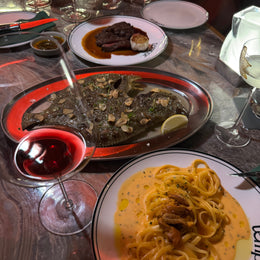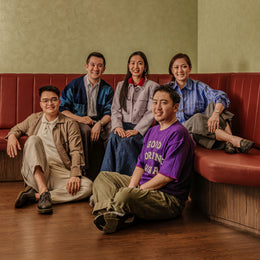
Shochu is indispensable to Japanese cuisine - popular impressions of Japan's national spirit revolve around salarymen and gruff workers chasing their late night meals down with a clear, boozy liquid, often amidst a smokey izakaya or diner.
![]()
I have also recently learnt that izakaya shochu tours are a thing in Kagoshima. Source: Klook

Undeniably, that's a fantastic way to enjoy a shochu: in a highball or on the rocks format. I daresay my favourite supper would be washing down a belly full of yakitori with ice-cold shochu - but what if shochu deserved more time of the day (or night)?
![]()
Source: Ishinomaki
Setsuri Ishinomaki is the fourth and most recent restaurant opened in July by the Ishinomaki Group, helmed by veteran restauranteur duo Chi Pin Han and Janice Chi (whom Janice, may I add, was the first female restaurateur in Singapore to attain the Master Sake Sommelier title!). The new izakaya-esque restaurant boasts four styles of Japanese grilling techniques under one roof: genshiyaki, warayaki, robatayaki, and rogama styles.

We've caught a glimpse of wagyu beef being roasted warayaki style (smoked and grilled over rice straws), and the aromas were as impressive as the visual spectacle. If only you were there!
However, our focus for today is Setsuri Ishinomaki's impressive shochu collection - sporting over 40 labels curated by none other than Janice herself. Whilst very much a sake maverick herself, she has recently fallen in love with Japan's national drink.

Most shochu come crystal clear, misleadingly similar to water. Source: Wikipedia
Here's a quick explanation of shochu: shochu (焼酎) is a distilled spirit native to Japan. The art of distillation made its way into Japan from the then Ryukyu Kingdom (present day Okinawa), before reaching the mainland via Satsuma Domain (present day Kagoshima). Originally starting out with sweet potatoes, the official list of ingredients to make shochu includes over 50 ingredients, though the more commonly seen ones are made from barley, rice, buckwheat and brown sugar.
![]()
Kyushu, the southernmost mainland island of Japan, is most associated with the distilled spirit - and in broad generalisations, each prefecture is famous for their respective ingredient. Source: MTC Sake
What really sets Setsuri Ishinomaki apart is that shochus are available by the glass, giving novices and enthusiasts alike much needed opportunities to taste a wide array of the booming craft. As you could tell, after hearing about Setsuri Ishinomaki's shochu-by-the-glass offering, I couldn't be more excited to head down to the venue.

Setsuri Ishinomaki is nestled within the Gucco Midtown building, a walk's away from the Bugis MRT.
I was ushered to my seat, and met Janice herself, who would be conducting today's media tasting. She has informed me that we would be tasting four imo shochus (shochu made with sweet potatoes). She has handpicked the shochus for their stark differences in flavour and texture - dispelling the myth that imo shochus "all taste the same".

Today's menu: Tsuboro Black Koji 粒露 黒麹造り ; ALO ALO アロアロ ; Marunishi Sleeping Lotus Frog まるにし 寝ぼすけ蓮蛙のター ; Yasashi Toki no Naka De 優しい時間(とき)の中で
Janice has also chosen to pick three shochus that are atmospherically distilled, and one that is vacuum distilled. Atmospheric distillation, also called joatsu jouryu 常圧蒸留, is seen more commonly in traditional styles of shochu making, where the fermented liquid (moromi) is heated up under atmosphere pressure to the normal boiling point of ethanol.
![]()
Source: honkakushochu-awamori.jp
Vacuum distillation, or genatsu jouryu 減圧蒸留, reduces the pressure inside the pot still, which then reduces the boiling point of ethanol for distillation to occur. This method preserves the more volatile esters and organic compounds within the moromi and distills them into the final distillate, which could be destroyed or lost during heating at higher temperatures. The styles of this shochu is expected to be more fruity, estery, and less packed in terpenes and heavy congeners.

The shochus were first served neat. Under Janice's guidance, we tasted the shochus side by side, comparing and sharing flavour profiles. In a broad overview:

I found the first shochu, the Tsuboro Black Koji Imo Shochu 粒露 黒麹造り, to be a typical, what-you'll-expect sort of imo shochu, but a lighter, more approachable style;

the ALO ALO アロアロ was confectionery on the nose, but boasted a deep, sweet-savoury pastry profile;

the third shochu Marunishi Sleeping Lotus Frog まるにし 寝ぼすけ蓮蛙のター was deep, rich and nutty through and through;

and last but not least, the vacuum distilled Yasashi Toki no Naka De 優しい時間(とき)の中で was dainty, bouncy, and reminded me of lychee juice and rose water.

We then experimented with our shochu of choice in two formats: chased with ice water, and with hot water. Both serving suggestions are common in Japan, and we found that the shochus evolve quite a bit with the different temperature treatments! I personally loved the first shochu, the Tsuboro Black Koji Imo Shochu warmed up, and the third shochu, the Marunishi Sleeping Lotus Frog , chased with ice water.

We'll be publishing our in-depth shochu reviews in due time!
Truth be told, I can't be more excited that shochu is slowly but steadily gaining ground in our sunny Singapore. It's been a long time coming, with how sake has enamoured the world, I whole heartedly believe that shochu deserves much love and attention for its meticulous craft and recent innovations too.

Janice will be stocking more labels in Setsuri Ishinomaki with time to come, and a few labels have already caught my eye and piqued my curiosity for a future visit. For anyone who's looking to get their start in shochu appreciation, I highly recommend catching Janice at Setsuri Ishinomaki!

@vernoncelli
P.S if shochu isn't quite your thing (yet I hope!), Setsuri Ishinomaki also boasts a respectable sake collection as well; and if you're lucky, you could catch brewers giving masterclasses on the premises too.
On a separate note, Janice was very generous and pampered us with a whole host of signature dishes. Here's a shortlist of the many that I thoroughly enjoyed:

Of course, we'll have to shoutout that amazingly smoked wagyu grilled warayaki style. The meat was tender, with just the right amount of rendered fat and fragrant smoke that when paired with the wasabi created a really memorable dish;

the Yasai Seiro (steamed vegetables served with ponzu sauce) was the perfect palate cleanser, with the fresh, naturally sweet and soft vegetables cutting through the heavier smoky dishes;

the Mentai Dashi Yaki Tamago is a must try from Setsuri - the barely set, almost scrambled egg tamagoyaki was creamy, sweet and bursting of umami when paired with that grilled mentaiko;

the underrated dish for me was this Iburigakko Shiitake and Cream Cheese cracker appetiser: forsaking table manners, I lapped up the remaining cream cheese after expending all the crackers;

with last but definitely not least, the Kani & Kinoko Nabe (crab and mushroom claypot rice) as a finisher to a satisfying meal. The crab miso and flesh wasn't heavy handed here, instead, the naturally sweet and buttery flavours of the crab translated into the claypot rice that was light, fluffy, and sating.
Compliments to the chefs!







